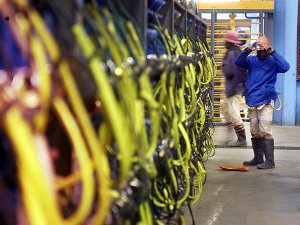
[miningmx.com] – IN one of life’s little ironies, the new-look Gold Fields
recently found itself confronted by some old-sounding problems.
Barely three months after unbundling its strife-torn, ageing South African mines into
Sibanye Gold, Gold Fields was faced with a wildcat strike at two of the mines it had
decided to keep: Damang and Tarkwa in Ghana.
The discontent was worringly familiar: workers were unhappy at the company’s profit-
sharing plans while they also demanded the reinstatement of a worker dismissed on
disciplinary grounds.
And in an echo of South Africa’s recent spates of xenophobic behaviour, workers
claimed expatriate employees at the mines were being treated better than locals.
They also wanted a certain manager dismissed.
These grievances remind one of the broad-sword approach of South Africa’s own
Associated Mineworkers & Construction Union (Amcu).
The flipside of having unbundled the 4.1 million ounce a year Gold Fields into two
smaller entities is that hiccoughs at the mines have a bigger impact.
Interestingly, while Gold Fields was trying to cool tempers in Ghana, Sibanye Gold
was contemplating closing its Beatrix West shaft, a section of the Beatrix mine in the
Free State province, which has been made inaccessible for more than a year by an
underground fire.
The strike action in Ghana – now over but potentially subject to the findings of
independent committee investigations – came at a sensitive time for Gold Fields.
The stock has not re-rated post the unbundling (what gold stock has done well
recently especially given the massive drop in the dollar gold price?). And while the
market has a glum view on all gold equities, there’s also talk that analysts aren’t sure
how Gold Fields is going to grow. It’s hard to come by hard and fast forecasts longer
than two years out, they say.
Gold Fields quickly moved to instil confidence in investors by publishing first (March)
quarter production guidance of some 476,000 ounces, enough to keep it on beam for
full-year output of between 1.83 million oz and 1.9m oz.
Were strike action at Damang and Tarkwa to be resumed, or it flared up again on a
different basis however, Gold Fields would have a problem with that guidance. The
two mines – Tarkwa is by far the biggest – comprise twice as much of total gold
production after the unbundling than before it (43%).
Tarkwa is also Gold Fields’ biggest margin gold producer with the second lowest cash
costs. It’s exactly the kind of mine Gold Fields CEO, Nick Holland, wants to see
performing well in order the company meet its promises of quality over quantity gold
production.
Even before the decline in the gold price, nearly all gold and other mining stocks were
getting a pasting anyway.
But since the beginning of February, Gold Fields’ share price has performed
particularly poorly; certainly worse than AngloGold Ashanti.
Sibanye Gold, meanwhile, the company that was supposed to be staring down the
barrel in terms of its US following at its listing in February, has seen little to no
liquidation, prior to the gold price weakness, especially among US shareholders.
A study by JP Morgan of Sibanye Gold’s share register during the first month of trade
shows that the US comprises 48% of total shares held, down from 49% when its
assets were part of Gold Fields; that is, pre-unbundling.
It needs to be borne in mind that this is only the first month of trade during a period
in which US shareholders couldn’t trade the share for its first week of trade which
started eleven days into February.
Nonetheless, US shareholders are not jumping the gun, while South African
shareholdings in Sibanye Gold has actually increased to 30.3% from Gold Fields’ 24%
South African shareholder base in September.
Only the UK has taken a dim view of Sibanye Gold’s risks which mainly turn on the
age of the mines and the socio-economic factors that weigh on South Africa as a
whole. Owing to the sell-down of shares by Black Rock, Sibanye’s UK shareholder
base fell to 4% from 10% in Gold Fields last year.
Meanwhile, the emergence of a more bellicose union presence on the mines in Ghana,
however, is surprising, although Gold Fields spokesperson, Sven Lunsche, says the
Ghana Mine Workers Union has been more active in the last few years.
That could perhaps relate to ongoing contact the our own National Union of
Mineworkers. Says Lesiba Seshoka: “We always have interaction with various unions
globally. And we are expected to play a leadership role in Africa’.
Frans Baleni, secretary-general of the NUM, is more open about recent contract
between the unions.
“We have communicated as we have done in the past with the Ghanaians since the
strike has started,’ he said. “On a lighter note, the first question we asked them was
if they have an Amcu [Associated Mineworkers & Construction Union] there or
not.’











